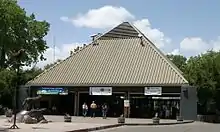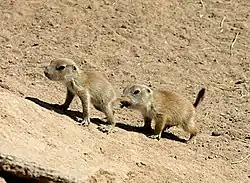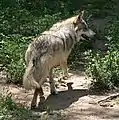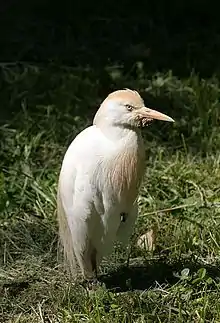Rio Grande Zoo
Founded in 1927, the 64-acre (26 ha) Rio Grande Zoo, located in Albuquerque, New Mexico, is a facility of the Albuquerque Biological Park. After a branding change, the Albuquerque Biological Park dropped "Rio Grande" from the name; the zoo is now called ABQ BioPark Zoo. Some of the most popular of the over 200 species are seals and sea lions, chimpanzees, gorillas, orangutans, elephants, polar bears, giraffes, hippos, camels, tamarins, koalas, Mexican wolves, cougars, monkeys, jaguars, zebras, and rhinos. Sections of the zoo include an Africa exhibit area, an Australia exhibit area, the "Cat Walk" and herpetology area. An endangered species carousel was added in 2016. A narrow-gauge railroad connects the zoo to the other facilities of the Albuquerque Biological Park. Walking distance through the zoo is 2.27 miles (3.65 km).
 Main entrance | |
| Date opened | 1927[1] |
|---|---|
| Location | Albuquerque Biological Park, Albuquerque, New Mexico, United States |
| Coordinates | 35.0776°N 106.6627°W |
| Land area | 64 acres (26 ha)[1] |
| No. of species | 200+[1] |
| Memberships | AZA[2] |
| Website | www |
The Albuquerque Biological Park is an accredited member of the Association of Zoos and Aquariums (AZA).[2]
Animals
The Rio Grande Zoo exhibit animals that pertain to various geographical areas. The zoo is divided into continents.
Africa
Reticulated giraffe, Grevy's zebra, white rhinoceros, common chimpanzee, spotted hyena, cheetah, marabou stork, lappet-faced vultures, Cape griffon vultures, hippopotamus, lion, rock hyrax, slender tail meerkat, serval, African crested porcupine, lowland gorilla, ankole, red river hog, warthog, hammerkop, saddle-billed stork, Stanley crane, cattle egret, dromedary camel, wolf guenon, DeBrazza's monkey, klipspringer, Madagascar ground boa, Madagascar tree boa, ostrich, African grooved frog, Lady Ross turaco, Aldabra tortoise, African wild dog, African pancake tortoise, Sudanese plated lizard, and African Slender-snouted Crocodile.
Australia/Oceania
Tasmanian devil, koala, echidna, Matschie's tree kangaroo, saltwater crocodile, lorikeet, carpet python, princess of wale's parakeet, wompoo fruit dove, emu, red kangaroo, laughing kookaburra, budgerigar, Micronesian kingfisher, palm cockatoo, Major Mitchell's cockatoo.
Asia
Asian elephant, snow leopard, Malayan tiger, king cobra, reticulated python, Indian python, wrinkled hornbill, pygmy slow loris, slow loris, orangutan, siamang, Komodo dragon, Chinese alligator, and Mandarin duck.
Arctic
North America
Bobcat, cougar, copperhead, milk snake, garter snake, desert tortoise, alligator, bison , black-tailed prairie dog, California sea lion, Mexican wolf, bald eagle, great horned owl, roadrunner, axolotl, golden eagle, turkey vulture, tiger salamander.
South and Central America
Caribbean flamingo, scarlet ibis, golden lion tamarin, spider monkey, howler monkey, Cuban amazon, hyacinth macaw, scarlet macaw, golden-collared macaw, Andean tinamou, vine snake, blue poison dart frog, green anaconda, angelfish, toco toucan, sunbittern, red-bellied piranha, emerald tree boa, tree boa, boa constrictor, dwarf caiman, jaguar, ocelot, two-toed sloth, military macaw, Andean condor, crested caracara, thick-billed parrot, hawk-headed parrot, cotton-top tamarin, sun conure.
Exhibits
Flamingo Crossing
A moated island located at the beginning of the zoo that holds the zoo's flock of Caribbean flamingos. The island is lush with bamboo vegetation and is also home to the zoos Scarlet Ibis and wild ducks.
Reptile House
The reptile house was remodeled in 2012 to include Chinese alligator, and alligator snapping turtle. With the renovations the building houses mostly reptiles. The exhibit houses many species of cobras, rattle snakes, and lizards. There are two large areas where the zoo's Komodo dragons are held. In a building located near the Reptile House the zoo's temporary home for a large adult salt water crocodile and for Slender-snouted crocodile. On the outside of the Reptile House is the new Gator Swamp Exhibit, which is a large outdoor heated pool housing several adult American alligators. The reptile house received more renovations in 2017 to improve digital interpretive signage and interactive displays. Other species on display in the true reptile house as of 2017 include: Bismark ringed python, Asian water monitor, Quince monitor, Cottonmouth, Mata mata Turtle, Black Mamba, Storr's monitor, Green Anaconda, Jumping Viper, Western Diamondback Rattlesnake, Gila Monster, Grand Cayman Blue Iguana, Rhinoceros Viper, White-Lipped Viper, Red Spitting Cobra, and Black Spitting Cobra.
Five Texas horned lizards, born in August 2019 at the Zoo, are now on exhibit in the reptile building. The zoo has been breeding the species since 2017. The Texas horned lizard has disappeared from about half of its historic range due to habitat loss, human eradication of the ant populations that these lizards eat and displacement of native ant populations by invasive fire ants. To date, the zoo has successfully released about 70 young into the wild in Socorro County, New Mexico.
Tropical Trail
The area formerly known as Phoenix Plaza has been repurposed as the zoo's Tropical Trail. This is located past the Birds of the Islands exhibit and Aldabra Tortoise yards. Here there is a curved array of exhibits mostly housing birds. Species housed here include: Ground hornbill, Helmeted guineafowl, Buff-crested bustard, Lady Ross's Turaco, Roadrunner, Northern Helmet Curassow, Gray-winged Trumpeter, Scarlet Ibis, Cattle Egret, Black Spurred-wing Goose, and a family of Black Howler Monkeys.
Raptors
Several large exhibits that hold the zoo's bald eagles, golden eagles, ferruginous hawk,Stellers Sea Eagles, crested caracaras and Andean condors as well as other birds.
Mexican Wolf Exhibit
This exhibit holds the zoo's pack of Mexican wolves, the most endangered species of wolf in the United States. In June 2020, Mexican gray wolves Kawi and Ryder welcomed seven pups! This is the pair's second litter. The Litter consists of five boys and two girls.
Inukshuk Bay
It offers many views of the polar bear. One can see them through underwater viewing windows or walk to the top of the exhibit and watch the bears lounge, feed, and slide down the waterfall.
The Cat Walk
Grottos in this exhibit hold African lions, cougars, snow leopards, jaguars, a Malayan tiger, ocelots, and red kangaroos. Smaller exhibits hold great horned owls, Fossa, African crested porcupine, bobcat, serval and meerkats. The Jaguars received a second large yard with pool and natural foliage in 2017. The zoo's two Jaguars will rotate between the two yards.
Amphibians: Life on a Limb
With the renovation of the Reptile House in 2012, the zoo opened up Amphibians: Life on a Limb, replacing the original Gator Swamp, where the zoo used to hold its juvenile alligators. The building houses poison dart frogs, hellbenders, and caecilians as well as other amphibians. The zoo also houses the only captive population of locust coquis, critically endangered frogs from Puerto Rico.
Asia
This exhibit contains several elephant yards and two barns for the zoo's Asian elephants. The exhibit now holds six Asian elephants in its herd, two males and four females. Rozana, also called Rozie, was born in the Rio Grande Zoo on November 8, 1992. On Sept. 2, 2009, Rozie gave birth to female elephant Daizy. Rozie gave birth to her second calf, Jazmine, on October 2, 2013. The virus, elephant endotheliotropic herpesvirus claimed Daizy's life on May 9, 2015. Rosie gave birth to her third calf, Thorn, in 2018.
Australia/Koala Creek
This area is under construction, but the open areas to the public house koalas, Matschie's tree kangaroos, and walk-through budgerigars aviary. Exhibits for tawny frogmouth and Sulphur-crested cockatoo are found nearby. This area also is home to the zoo's Tasmanian devils. There are only a few zoos in the US that house these animals. The zoo also has on exhibit the only Tasmanian wombats in the United States. A seasonal Lorikeet feeding station is found inside the Lorikeet exhibit that houses Rainbow Lorikeets, Red Lory, and Chattering Lory. A new emu yard was added in the location of the old Ankole yard.
In September 2018 the zoo started making major progress in an expansion of the area with several different plans being put in motion. The zoo closed its Seal and Sea Lion pool, and the area will be repurposed in the expansion. New animals to be included in the expansion are Dingo, Little Blue Penguins, Wallabies, and the return of Koala's to the zoo. The Zoo will have and updated exhibits for most of its current animals and be a new home for the zoo's Salt Water Crocodile.
Lemurs & Night watch
Exhibit holding slow loris and pygmy lorises. The connected outdoor exhibit is home to a pair of black and white ruffed lemurs. The Zoo has had success breeding the lemurs with baby Bruno born in May 2016, twins Finch and Cricket born in May 2017, and in April 2018, Izy was born. They are all the offspring of female Nuit and male Darby. Darby’s brother, Kirby, also lives with the group.
Africa
Six acres of land holding 17 separate exhibits and 23 species of mammals and birds. Mammals include chimpanzees, warthogs, red river hogs, cheetahs, Hartmann's mountain zebras, white rhinoceroses, hippopotami, klipspringer, De Brazza's monkey, spotted hyenas and African wild dogs. Birds include including marabou storks, Cape griffon vultures, lappet-faced vultures, wattled cranes, common ravens, hammerkops and saddle-billed storks. Out of continent animals on display in the area include: Capybara and Reeve's Muntjack. The Zoo welcomed two hyena babies in May 2020. This is the second pair of hyena cubs for parents Smilla and Dubu. The first pair, Havoc and Ruckus headed to the Fort Wayne Children's Zoo in May 2020.
Apes
Holds the zoo's gorillas, orangutans, and siamangs. A Gorilla Bacholors Pad is found near the Nightwatch as well. The siamangs welcomed a new addition on April 5, 2017 - a new baby named Eerie.
Birds of America
Opened in 2016, this aviary exhibit includes hyacinth macaw, sun conures, burrowing owl, and roadrunners in a mixed species exhibit.
Penguin Chill
In July 2019, the highly anticipated penguin chill exhibit opened. The multi-million dollar exhibit was funded through a city tax bond. The exhibit features gentoo penguinss, macaroni penguins and king penguins, and is the first of its kind in the Southwest. The 14,550 square foot building includes a 75,589 gallon main tank, above-ground and underwater guest viewing areas, a large interactive educational area and an outdoor deck overlooking the Zoo's main park. The outdoor deck includes restrooms and a snack bar. The exhibit begins with a themed main viewing deck will with a panoramic view to visitors. The main pool depths varying from 5-12 feet allows for plenty of space for penguin activity including special public feedings with keepers, swimming and enrichment. There is a glass floor area allows guests to see penguins swimming beneath their feet as your travel through the exhibit.The exhibit includes a natural day/night and seasonal lighting cycles help regulate the penguins' hormonal balancing and breeding. The Zoo had early hopes for baby penguins with two Macoroni Penguin eggs being discovered in 2020, however both eggs were discovered to be infertile.
Birds of the Islands
Opened in 2020, the zoo opened the Birds of the Islands exhibit on the location of the former Parrots. The newly updated are includes Princess of Wales Parakeet, Australian King Parrot, Red Lory, Major Mitchell’s Cockatoo, Superb Starling, Bali Myna, Wrinkled Hornbill, Guam Kingfisher, Cuban Amazon Parrot, Nicobar Pigeon, and Socorro Dove. This new exhibit is part of the Zoo's Tropical Trail.
Future Exhibits
- The is taking steps towards an Asia expansion, with ground breaking ceremonies in place, the zoo plans to relocate many of its species with new larger yards and exhibits for Malayan Tigers, Snow leopards, Orangutans, Siamangs, Stellers Sea Eagle, Chinese Alligators, and various turtles. The zoo plans on adding new species of birds as well.
- The is planning on an Australia expansion with a new homes and exhibits for the zoos Red Kangaroos, and salt water crocodiles. The zoo is looking to add new species such as little blue penguin and dingo. The zoo is hoping to have the return of a former iconic species in Kolas.
- Upon completion of Zoos Asia and Australia areas, the newly empty exhibits on the zoos Carnivores section will be redone and reporpused for South American Animals and an expansion of the Polar Bear Holding area.
Former Exhibits/ Former Residents
Bacterian Camels/Takins
The zoo held Bactrian camels in a large yard located near the zoos large elephant yards. The Zoo expanded the elephant exhibit in 2018 with the inclusion of an expanded barn, in this area. The Zoo moved the last Camel, Betty, into the former Takin exhibit at the zoo until her passing. The Zoo no longer holds Camels. The Zoo held Takins in tow large yards in the Africa section, located behind the Giraffe barn. The zoo held the species for several years.
Seals and Sea Lions Exhibit
Large exhibit with underwater viewing tank that houses sea lions, gray seals, and harbor seals.
Frances V.R. Seebe Tropical America building
Indoor rainforest that housed golden lion tamarin, cotton-top tamarin, spider monkey, howler monkey, Cuban amazon, Andean tinamou, vine snake, green anaconda, angelfish, red-bellied piranha, toco toucan, sunbittern, emerald tree boa, two-toed sloth, shovel nosed catfish, redtail catfish, and bats.
Ankole Cattle exhibit
Located at the end of the Africa section, it has been updated and now houses Emu at the end of the Australia section.
Echidna
A simple nocturnal exhibit in the Australia section housed echidna.
Lemurs
The current Lemur exhibit has housed Lemurs at different times. In the 1990s-early 2000s it housed Black-and-white ruffed lemurs and Red ruffed lemurs. After a period housing tree kangaroos, Lemurs returned. Blue-eyed black lemurs were housed in the exhibit temporarily.
Reptile House
The building initially held zoo's reptiles and amphibians. However, now the amphibians are found in Amphibians Life on Limb. Former Reptile species held include: Death Adders, Taipan.
Catwalk/predators
This section of the zoo has housed many species of animals throughout its time. It has housed Leopards, Clouded Leopards, Tayra, Hyraxes, Red Panda, and Reeve's Muntjac, among others. The final exhibit, the Tiger yard has housed White Bengal Tigers and Bengal Tigers in the past.
Emu Yard in Cat walk
Remodeled into a larger Jaguar yard. Emus relocated into Australia.
Zebra Yard
The Zoo formerly housed Grevy's Zebra in the Zebra Exhibit as well as Ostriches. In addition, prior to the zebras’ arrival in 2002, the yard housed Bison.
Bear Grottoes
Between 1972 and 1996, three grottoes located between the present Wolf and Polar Bear habitats housed Polar Bears, Grizzly Bears, and Malayan Sun Bears. The grottoes still stand as of 2020, albeit vacant and fenced off to the public.
Other Former species
Saiga antelope, Persian goitered gazelle, Himalayan tahr, West Caucasian tur, Gemsbok, Greater kudu , Banteng, Siberian ibex, Markhor, Sichuan takin, Pronghorn.
Gallery
 Two juvenile black-tailed prairie dogs
Two juvenile black-tailed prairie dogs A sleeping male African lion
A sleeping male African lion

 Old Rio Grande Zoo sign at zoo entrance
Old Rio Grande Zoo sign at zoo entrance The train engine crossing a path in the zoo
The train engine crossing a path in the zoo
See also
Notes
- "Zoo". City of Albuquerque. Retrieved 30 April 2011.
- "Currently Accredited Zoos and Aquariums". aza.org. AZA. Retrieved 30 April 2011.